Mathoor Kalari was extremely supportive in nurturing martial arts and various other performing arts of Kerala. The patronage and cultural legacy of the family led to the origin of new art forms like ‘Velakali’ and also contributed to the evolution of performing arts like Kathakali, and Thiruvathirakali.
Culture & Legacy
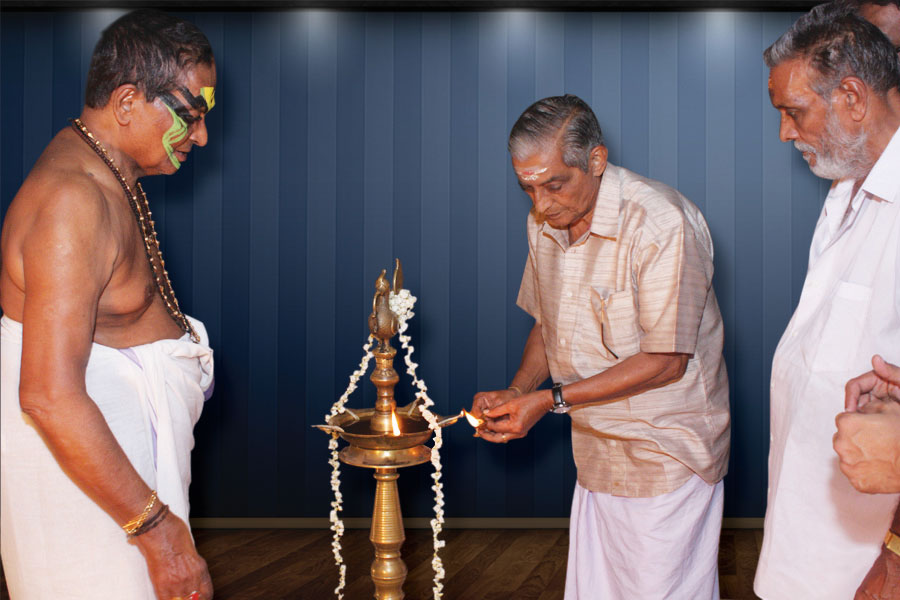
CULTURAL HERITAGE OF MATHOOR
HERITAGE
Mathoor Kalari was extremely supportive in nurturing martial arts and various other performing arts of Kerala. The patronage and cultural legacy of the family led to the origin of new art forms like ‘Velakali’ and also contributed to the evolution of performing arts like Kathakali, and Thiruvathirakali.
MATHOOR KALARI
Mathoor Kalari (the traditional school for learning martial arts) was set up by Mathoor Panicker to impart learning of martial arts ‘kalari payattu’, fencing and other art forms.
Mathoor Kalari was very famous with its superlative degree of perfection in fencing and other forms of martial arts. It is noteworthy that the then crown Prince of Travancore, Karthika Thirunal, had stayed in disguise for months at the Mathoor kalari to master the rarest techniques of martial arts from the Mathoor Panicker and the Guru Dronampally Acharya.
With the changing times, the significance of ‘kalaripayattu’ learning has declined. The Mathoor family is wishful of reviving and re-igniting the interests in Kalaripayattu among the younger generation.
Mathoor Kalari Trust is a registered organisation under the Indian Trust Act 1882 with the registration number IV/74/2018, which is the governing body to manage the monument and the Training school. The primary object is, to revive the interests in Kalari and martial arts among the younger generation and to organise and promote classical arts of Kerala. The Mathoor Kalari Trust Facebook group also actively propagates the latest developments in martial arts, and traditional art forms of Kerala among the followers.
Efforts are now on, under the aegis of the governing body, to restore the Kalari to its past glory. The Mathoor Temple and Kalari, located in Alappuzha in Kerala, remains a nostalgic landmark for connoisseurs of Kathakali and other traditional art forms.
Mission of the Trust
Resurrection, research, and reinvention of a centuries old Cultural Center and school for traditional temple art forms which can augment the rich cultural heritage of India and in turn contribute to the society.
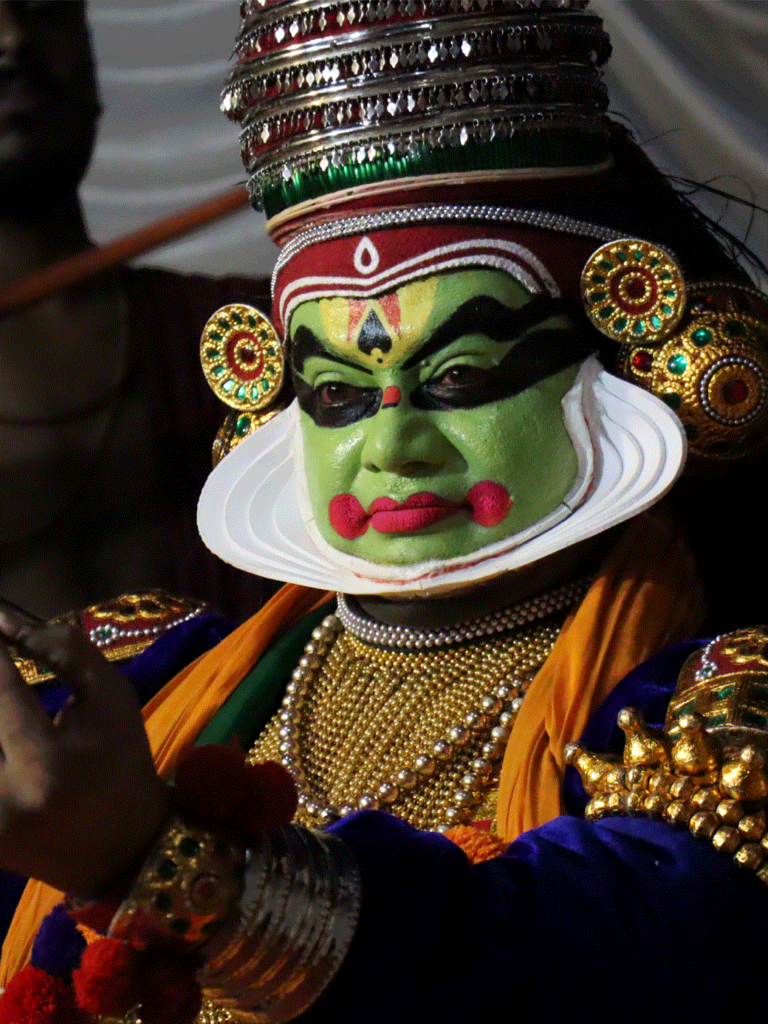
KATHAKALI AT MATHOOR KALARI
Mathoor Kalari patronised several performing arts of Kerala. The family not only nurtured many artistic talents at the Mathoor kalari but also served as a platform for many illustrious artists to experiment and contribute to the evolution of performing arts like Kathakali.
RENOWNED KATHAKALI ARTISTS OF MATHOOR KALARI
Mathoor KalariThe great Kathakali artist, late Shri Mathoor Kunjupillai Panicker, was an actor with impeccable quality, versatile style and one of the most respected gurus in the field of Kathakali, with a multitude of disciples in the likes of Shri Chengannur Raman Pillai, Shri Champakkulam Pachupillai and Shri Guru Gopinath.
RENOWNED KATHAKALI ARTISTS OF MATHOOR KALARI
The great Kathakali artist, late Shri Mathoor Kunjupillai Panicker, was an actor with impeccable quality, versatile style and one of the most respected gurus in the field of Kathakali, with a multitude of disciples in the likes of Shri Chengannur Raman Pillai, Shri Champakkulam Pachupillai and Shri Guru Gopinath.
MATHOOR KUNJUPILLAI PANICKER (1873-1929)
Shri Mathoor Kunjupillai Panicker (son of Mathoor Krishnankunju Panicker) was born in 1873. He was taught by his erudite father from whom he learnt Sanskrit, literature, arts and drama. Along with that, he started learning kathakali from Shri Shankara Pillai who was the ashan (master) of Mathoor kalari. At the age of eighteen, Mathoor Kunjupillai Panicker had his arangettam (first performance) in kathakali where he donned the character of Ravana in Karthavirya Vijaya. His performance and talent in kathakali was widely acknowledged by the audience and he became the main artist in the Thoppil kathakali group. He established the Mathoor kathakali group where Kavungal Shankara Panicker also became a notable artist. Both the artists made the Mathoor kathakali group a highly prestigious platform to disseminate kathakali across Kerala. This led to the meeting of Shri Mathoor Kunjupillai Panicker with the great poet Mahakavi Vallatholl Narayana Menon. Their artistic inclinations led to the blossoming of great friendship between the two. Mathoor Kunjupillai Panicker became an indispensable member of Vallatholl’s team of artists who conducted international tours. With great ease, Mathoor Kunjupillai Panicker could perform kathakali and play the parts of several diverse characters, the famous ones being Dharmaputrar, Bhiman, Arjunan of Kottayam kathakali, Brihanalla of Utthara Swayamvaram, Nalan and Bahukan of Nalacharitham, Ravanan of Ravanavijayam, Brahmanan of Santhaanagopalam, and lastly, Kaattalan of Kiratham.
Kathakaliprakashika: Mathoor Kunjupillai Panicker wrote the first Natyashastra text in Malayalam known as Kathakaliprakashika. It is in the form of a dialogue (question and answer) between a Brahmana and his wife after watching a kathakali performance. Kathakaliprakashika was first published in the year 1922. In contrast to the existing texts on kathakali, this new Natyashastra text was written in lucid poetic form which appealed to the masses. In the foreword to Kathakaliprakashika, Mahakavi Vallatholl Narayana Menon has stated thus: “The pathway to the land of happiness which is Kathakali lies in this small book. Lighting up this way obliterating the darkness is none other than Mathoor Kunjupillai Panicker who is the authority among Kathakali artists, capable of guiding even the Masters of this art.” (Source: Kala Kaumudi, 25 Oct- 1 November 2020)
Mathoor Kunjupillai Panicker, the doyen of Mathoor Kathakali tradition passed away in 1929. He still remains as the guiding spirit to the Kathakali tradition of Kerala to this day.
MATHOOR GOVINDAN KUTTY (1940-2021)
Mathoor Govindan Kutty (5 October 1940 – 4 February 2021) was one of the greatest exponents of Kathakali in contemporary Kerala. In a career spanning over six decades, he specialized in Kathakali Stri Vesham, the portrayal of female characters on stage. He was the recipient of the 2011 Kerala State Award for the best Kathakali artist and the 2005 Sangeet Natak Akademi Award for contributions to the Kathakali art form.
Mathoor Govindan Kutty started his training in Kathakali, with Nedumudy Kuttappa Panicker at the age of 14 and went on to train under artists including Kurissi Kunjan Panicker, Ambalappuzha Shekharan. He was later trained under Kudamaloor Karunakaran Nair at the Thekkan Chitta Gurukulam. Under Nair’s tutelage, he specialized in Kathakali Stri Vesham, or the portrayal of female characters, and would continue to do so through his career of over six decades. He credited Nair’s portrayal of Damayanti as an inspiration for his choice of female characters. Some of his lead roles included performances with other prominent artists including Kalamandalam Gopi, Kalamandalam Krishnan Nair, and Mankulam Vishnu Namboothiri.
Some of the popular characters that he portrayed included Damayanti in Nalacharitham, Kunti in Karnasapatham and Panchali in Duryodhana Vadham.
As a teacher, he also trained many artists at the Kudamaloor Kalakendra (centre for the arts). He led the performance of Kudamaloor Kalamandram group at the opening ceremony of the 1982 Asian Games and at the 1993 Kathakali Mahotsav. In addition to performances in India, he had also performed internationally in England, France, and Germany. His last performance was two weeks before his death, where he portrayed the role of Kunti in Karnasapatham.
Mathoor Govindan Kutty was the recipient of the Sangeet Natak Academy Award for advancing contributions to the Kathakali art form. The citation from the Academy called him “one of the foremost exponents” of the art form. He was honoured with the Kerala Kalamandalam award, Madavoor Vasudevan Nair award, and the Kerala Sahitya Academy award. He was a member of the governing body of the Kerala Sahitya Academy, had held a central fellowship from the Union Government and was awarded the 2014 Kalamandalam fellowship.
Mathoor Govindan Kutty served as the President of Mathoor Devaswom for several years and organised several Kathakali performance at the Mathoor temple. His son , Kudamaloor Muraleekrishnan, a wellknown Kathakali artist on his own right and grandson have also performed with elan at Mathoor temple, thus continuing the artistic tradition of the Mathoor family.
The great Kathakali exponent Mathoor Govindan Kutty passed away in February 2021.
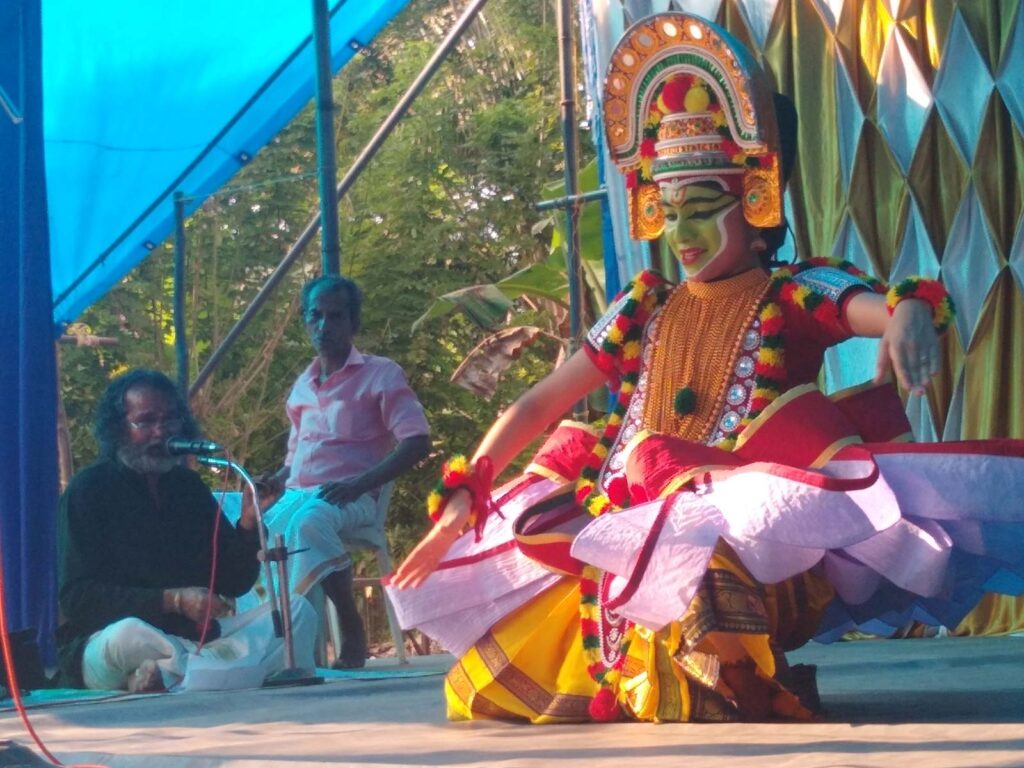
KUNCHAN NAMBIAR, OTTAMTHULLAL AND MATHOOR
Kalakkathu Kunchan Nambiar (1705 -1770), the master of Malayalam satirist poetry, founder of Ottam Thullal and one among the ‘Mahakavi’of Malayalam literature, was the disciple of Mathoor Panicker, during his youth at Ambalappuzha. Kunchan Nambiar has stayed at the Mathoor homestead for several months during his lifetime being a close associate of Mathoor Panicker. It is noteworthy that Kunchan Nambiar learnt Kalari Payattu and Sanskrit from masters like Mathoor Panicker, Dronambally Acharya during his youth spent at Mathoor Kalari.
It was Mathoor Panicker who encouraged Kunchan Nambiar and provided all hospitality at Mathoor Kalari when he fell out with Nangyar at Ambalappuzha, which led to the origin of Ottamthullal, a new performing art devised by Nambiar. Thus ‘Thullal’ as a performing art, originated in Mathoor Temple. Several Thullal stories were written by Kunchan Nambiar at Mathoor Kalithattu.
Nambiar devised this new performing art known as Thullal to wean the people away from Nangyar’s Chakkiyar Koothu, which was the popular art form at Ambalappuzha. He wanted to use Malayalam as opposed to the stylized and Sanskritized language of Koothu which could not be understood by ordinary people. Ottamthullal was full of humour and satire which appealed to the masses. Kunchan Nambiar is believed to have written over forty Thullal compositions.
Kunchan Nambiar strongly believed that it was the blessings of Mathoor Bhagawati (Temple Goddess) which helped him in evolving the art form of Thullal. Nambiar’s devotion was evident in the lines towards the end of the ‘Sabha Pravesham Thullal’ wherein Nambiar has written:
അമരസേവിതെ, മാത്തൂരമരുംശ്രീമഹാഭദ്രെ !
മമതായേമഹാമായേമമതാവാരിധേദേവി,
നമസ്തേ!ലോകമാതാവേ, നമസ്തേ!നായികേനാഥേ
നമസ്തേ!മല്കലാധാരേ, നമസ്തേമംഗളാകാരേ !
Amarasevithe, Mathooramarumsreemahabhadre!
Mamathaayemahamaaye mamathavaridhe devi,
Namasthelokamaathaave! Namashthenayikenaadhe! Namasthekalaadharemal, Namashthemangalakaare!
It is documented in Nagam Ayyar’s Travancore State Manual Volume I (pages 346-347),that during the reign of King Marthanda Varma, Mathoor Panicker and Kunchan Nambiar along with the Thullal artists visited the King of Travancore. On performing ‘Thullal’ , the Maharaja Marthanda Varma, the King of Travancore presented several gifts to Nambiar and Mathoor Panicker. This incident has been noted by the great poet, Mahakavi Ulloor S Parameswara Aiyyar in his ‘Sahitya Charitram’ of Kerala. Kunchan Nambiar has written the Mathoor Ambikashtakam, which depicts his devotion towards Mathoor Bhagawati. The Mathoor Ambikashtakam are recited by the devotees of Mathoor Bhagawati for ‘abheeshta sidhi’(blessings).
MATHOOR PANICKER AND THE ORIGIN OF VELAKALI
“Velakali“ is another classical dance form, which originated at the Mathoor Kalari. Velakali is a form of ‘war dance’ devised by Mathoor Panicker as Chief Commander of Army of Chembakassery Raja, to popularise the discipline, movements and strength of martial arts/‘kalari payattu’ among the masses. The Velakali is performed only by men. It has its unique costume and head gear which symbolises war and the rhythmic movements kindle the spirit of martial arts among ordinary men.
Velakali, to this day is a regular feature of the temple festival (pooram) at the Ambalapuzha Sri Krishnaswamy temple. In recent years, Velakali has marked the commencement of the annual Painkuni festival at Sri Padmanabha Swamy Temple, Thiruvananthapuram.
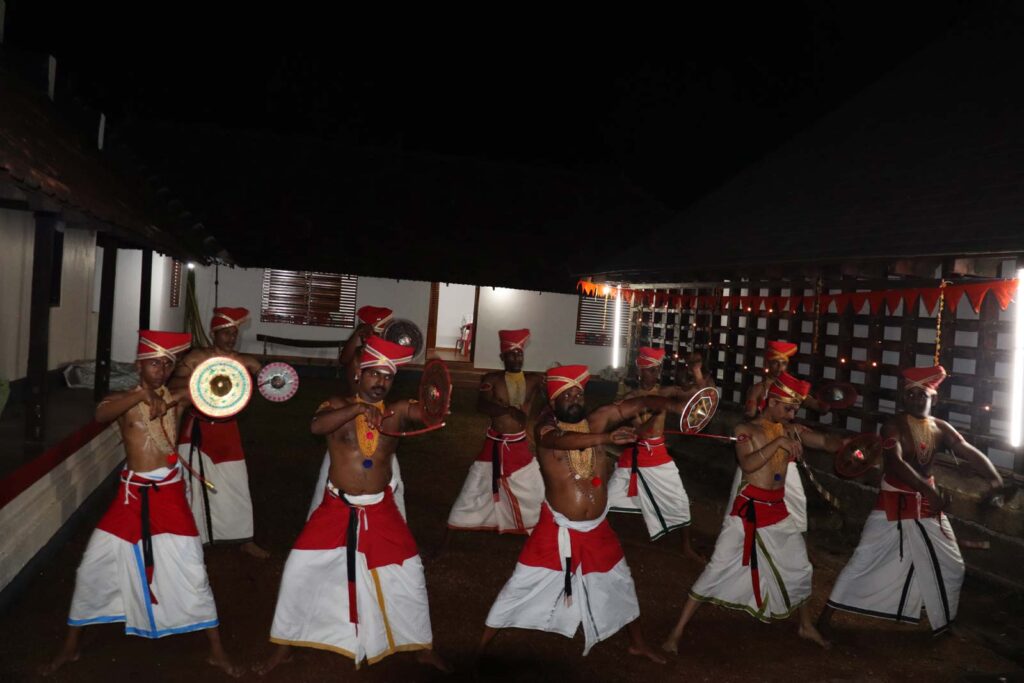 Renowned Velakali Artist: Mathoor Mohanankunju Panicker
Renowned Velakali Artist: Mathoor Mohanankunju Panicker
Mathoor Mohanan Kunju Panicker (1936 -2003), was a great exponent of Velakali, the traditional dance form of Mathoor family. He was the son of the late Karthiyani Kunjamma, Valiakunnil, Nedumudi and he devoted his entire life to propagate this dance form across India and abroad. Mathoor Mohanankunju Panicker was a very popular ‘Velakali’ guru and through his efforts ‘Velakali’ became an inseparable part of many major festivities in Kerala. It is a unique achievement that he has been able to present ‘Velakali’ in the Republic Day Parades in New Delhi continuously for several years. His contribution to this ancient art form earned him the Fellowship of the Department of Human Resources, Sangeetha Nataka Academy Award and the Fellowship of the Folklore Academy. He is one of the distinguished members of the family who was able to take the art form of Velakali to greater heights.
The legacy of Mathoor Mohanankunju Panicker is being continued by his son, Mathoor Rajeev Panicker, who organises Velakali at Ambalappuzha on behalf of Mathoor Kalari.
KALAMEZHUTHUM PATTUM
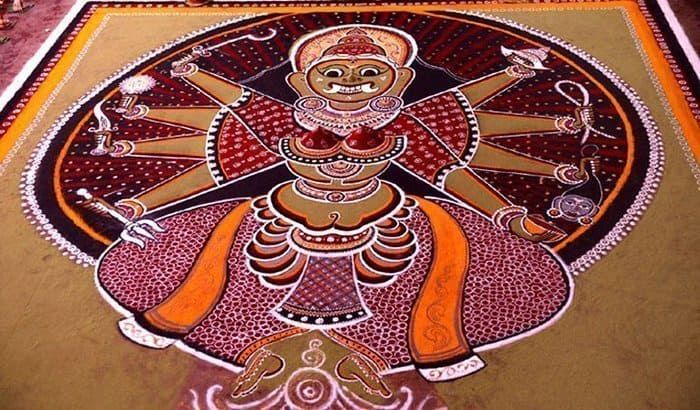
Another traditional ritual followed by Mathoor Kalari is the ‘Kalamezhuthum Pattum (picture painting and song)’ vazhipadu for Mathoor Bhagawati . The picture of Bhadrakali Devi is painted on the floor inside the temple using the colours of red, while, green, red and yellow made from natural materials. Accompanied by Pooja rituals, songs and dance, the ritual is conducted for the blessings of Bhagawati.
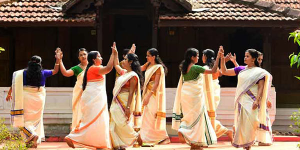
LEGACY OF THIRUVATHIRA FESTIVAL CELEBRATIONS
Thiruvathira, is a festival for women traditionally celebrated at Mathoor Temple by the family members with great fervour and devotion. Thiruvathira is the nakshatra or “star” of Lord Shiva as per the Malayalam calendar. It is believed that on this day, the Goddess Parvati finally met Lord Shiva after her long penance and Lord Shiva took her as a saha-dharma chaarini (equal partner). Both Parvati and Shiva present this ideal to devotees in the form of Ardhanarishvara (half male, half female form). The unmarried women observe a partial fast on this day to get good husbands and married women take a fast from the preceding day (Makayiram nakshatra) and on the day of Thiruvathira for the well-being of their husband and family. The first Thiruvathira of a newly wedded woman is known as Poothiruvathira. The Thiruvathira fast essentially involves abstaining from rice-based food. The typical meal includes cooked broken wheat and Thiruvathira puzhukku, a delightful mix of tuber vegetables, followed by the dessert dish of koova payasam.
Thiruvathirakali is a dance form performed by women on the day of Thiruvathira to the accompaniment of Thiruvathira paattu, folk songs telling tales of lovesick Parvati, her longing and penance for Lord Shiva’s affection and Shiva’s might and power. The dance is performed by women around a nilavilakku embody lasya or the grace of the feminine movements. The dance follows a circular, pirouetting pattern accompanied by the clapping of hands and singing. The rhythmic and attractive steps of Thiruvathirakali are taught by elder women to the younger generations traditionally.
Thiruvathira, the traditional festival is celebrated at Mathoor Kalari every year and ‘thiruvathirakali’ is open to public and not just limited to family members. Thiruvathirakali is also being taught to the new generation of girls by family members. Smt. Sitalakshmi of Mathoor is an exponent of Thirvathirakali and Thiruvathira pattu who has been teaching girls this beautiful dance form for more than three decades.










Other Pages

Developed by Pixelpearl Media
Copyright © 2024. All rights reserved.



